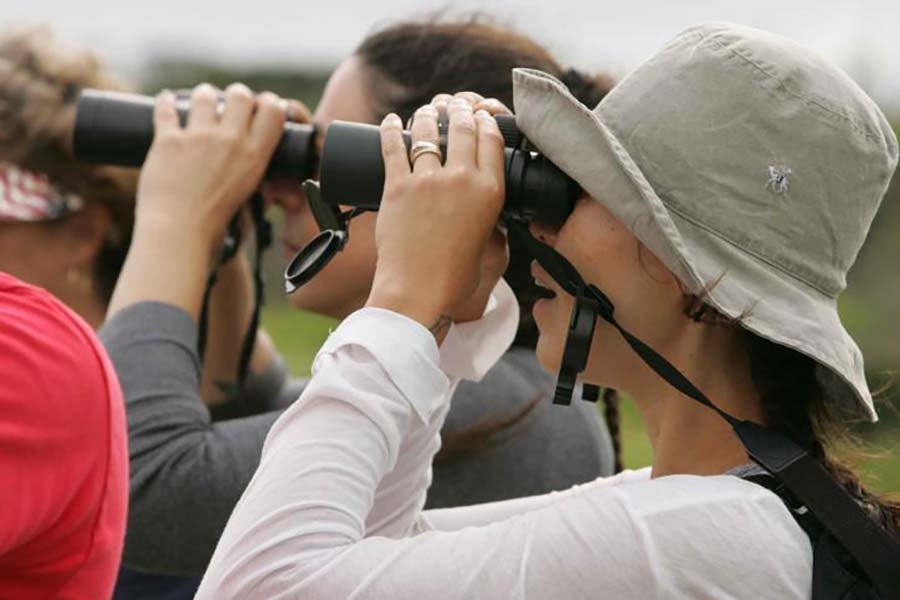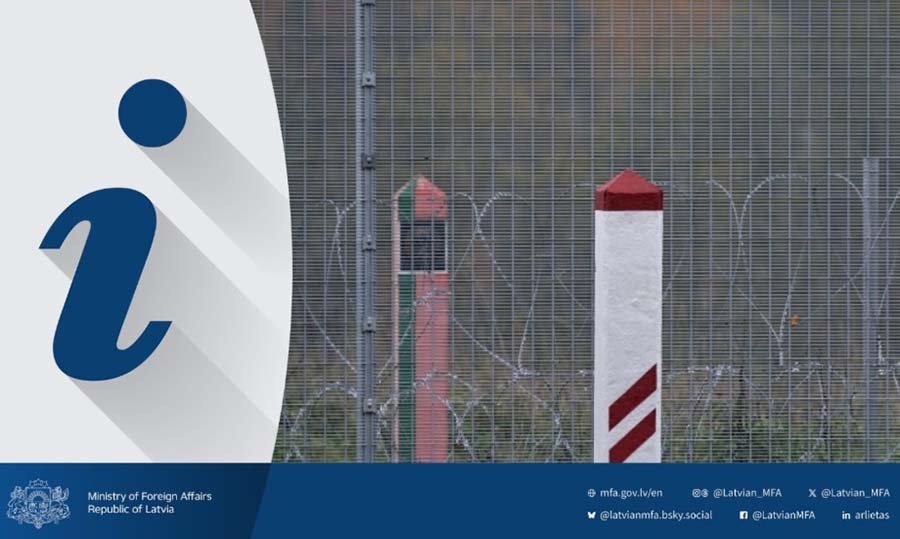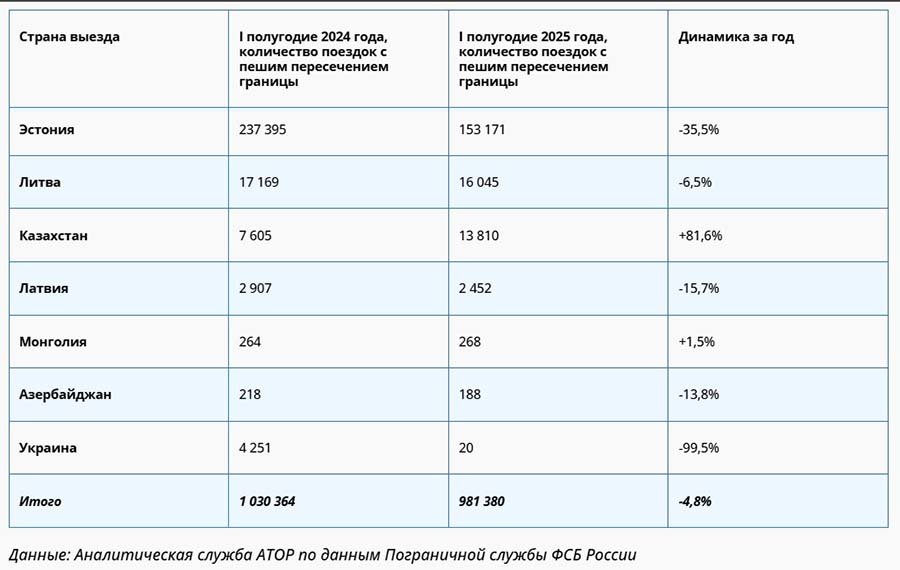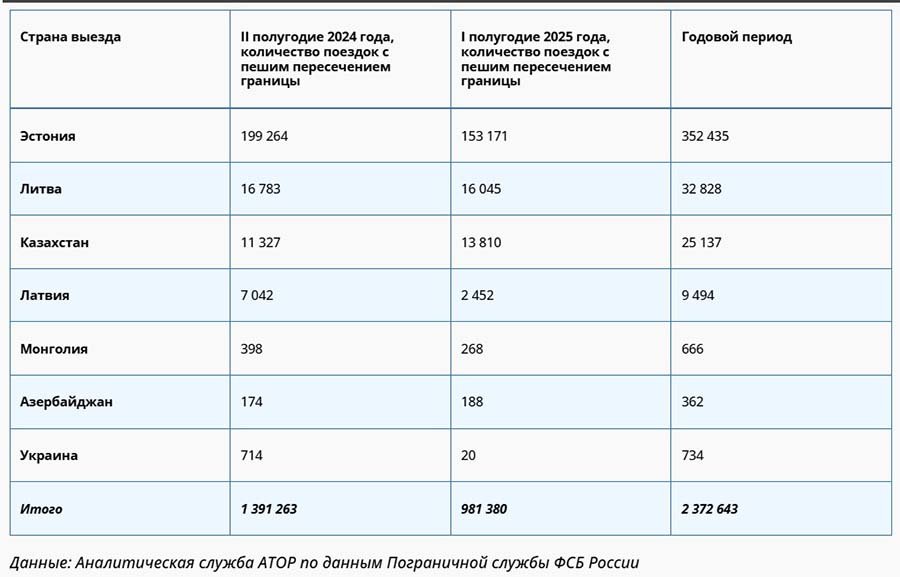читайте также
 Turkey plans to abolish the all-inclusive system in hotels
Turkey plans to abolish the all-inclusive system in hotels
 How Digital Nomads Are Transforming Cities and Economies
How Digital Nomads Are Transforming Cities and Economies
 Housing Market Bubble Risks in 2025 – UBS Data
Housing Market Bubble Risks in 2025 – UBS Data
 Artificial Intelligence in Tourism: Market to Grow 4.5 Times by 2030
Artificial Intelligence in Tourism: Market to Grow 4.5 Times by 2030
 Spain’s Rental Housing Market: Foreigners Granted Tax Deductions
Spain’s Rental Housing Market: Foreigners Granted Tax Deductions
 European Commission Reviews Complaints on Rights Violations of Russians in Latvia
European Commission Reviews Complaints on Rights Violations of Russians in Latvia
Where Russians Cross Borders on Foot

Photo: ATOR
Russians cross borders on foot nearly 2.4 million times a year, according to statistics from the FSB Border Service, analyzed by the Association of Tour Operators of Russia (ATOR). While this method formally ranks third after air and car travel, these figures are driven not by tourist flows but by border regulations.
In the first half of 2024, Russians crossed the border on foot 1,030,364 times. In the same period of 2025, the figure dropped by 4.8% to 981,380. The sharpest decline was recorded in the Baltic states, where rules for Russian citizens have been tightened and crossings are banned on many grounds.

Estonia: queues and restrictions
In Estonia, crossings fell from 237,395 to 153,171, a 35.5% drop. Tourist entry for Russians has been banned since September 2022, and since February 2024, the Narva checkpoint only allows foot crossings. This made Estonia a leader in the statistics but also created chaos: people wait up to 8–10 hours to return to Russia, sitting on chairs they bring with them, with volunteers distributing water. Informal “queue brokers” charge €50–80 for a place.
Interior Minister Igor Taro linked the issue to the ongoing conflict in Ukraine and Estonia’s commitment to fully comply with sanctions: “We must check every person and every item exported to Russia. Night shifts won’t reduce the queues, they’ll just redistribute them. Opening a new checkpoint is not being considered.” The Interior Ministry is more likely to consider closing the Narva crossing altogether rather than easing the rules.
Lithuania and Latvia tighten rules
In Lithuania, foot crossings dropped from 17,169 to 16,045 (–6.5%), mostly through the Chernyshevskoye/Kybartai checkpoint used for transit to Kaliningrad. Lithuania does not accept Russian tourists, has banned Russians from buying property, and even penalizes frequent return trips. In July 2025, the first Russian lost their residence permit for such visits, with 34 similar cases under review.
Latvia saw crossings fall from 2,907 to 2,452 (–15.7%). In March 2025, it completely banned pedestrian border crossings for Russians. Since September 1, new rules require all third-country nationals, including Russians, to submit an online application at least 48 hours in advance, with approval required for entry. Interior Minister Rihards Kozlovskis cited national security concerns.
Ukraine, Kazakhstan, and others
Ukraine has virtually disappeared from the statistics: from 4,251 crossings in early 2024 to just 20 in 2025. By contrast, Kazakhstan showed growth: crossings rose from 7,605 to 13,810 (+81.6%), as locals use pedestrian checkpoints for short trips to relatives or shopping.
In Mongolia, just 264 crossings were recorded in early 2024 and 268 in 2025 (666 total). Most border traffic occurs by car, with passenger transport through the Kyakhta checkpoint operating as a business. Occasional foot crossings are rare exceptions. In Azerbaijan, crossings dropped from 218 in early 2024 to 188 in 2025, reflecting closed land borders for private travel since the pandemic.

Where foot crossings are impossible
Certain directions prohibit pedestrian crossings altogether. At the Chinese and Norwegian borders, there are no pedestrian lanes, and entry is only possible by car or bus. Entering Georgia on foot from Russia is also impossible, except in emergencies, such as the 2022 record influx. These cases are excluded from the statistics, although Russian tourism in Georgia continues to grow, with Russians leading among foreign visitors.





